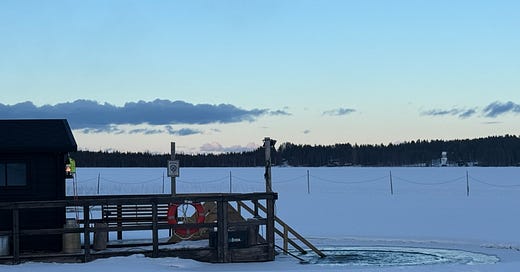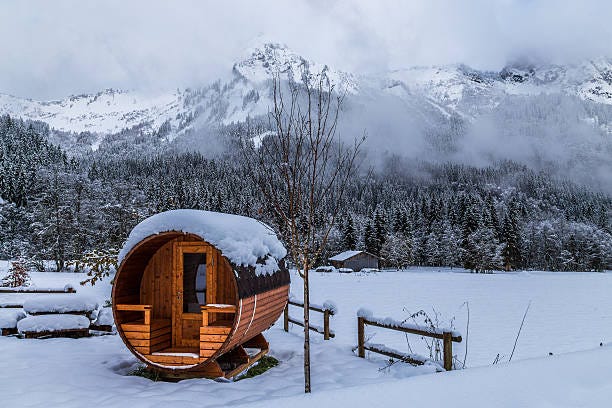Exploring Finland and the Fascinating World of Sauna Culture.
Experiencing Sauna the Finnish Way
Just last week, I had the chance to experience sauna culture firsthand in Finland, and it completely changed how I see this tradition.
For Finnish people, the sauna isn’t about luxury, trends, or chasing wellness fads—it’s a way of life, deeply ingrained in their culture. Whether in a tiny wooden cabin by a frozen lake or a simple electric sauna in a city apartment, the focus is on the experience itself. It’s a place to unwind, reflect, and even connect with others. I saw friends casually stepping out of a sauna and plunging into an icy lake as if it were second nature. Even in workplaces and government buildings, saunas are common, serving as spaces for both relaxation and important discussions. This deep-rooted sauna culture, passed down for generations, is something you don’t just observe—you feel it in every breath of hot, steamy air.
The Origins of Sauna: Who Invented It?
The sauna, as we know it today, originates from Finland, where the first versions date back over 2,000 years. The earliest Finnish saunas were simple pits dug into the ground, later evolving into wooden structures heated by stone stoves. The word “sauna” itself is Finnish, making it one of the few Finnish words widely recognized around the world.
Saunas were originally used not only for bathing but also for healing, childbirth, and even smoking meat. Over time, the practice spread to other cultures, each adapting it in unique ways.
Cultures That Integrate Sauna into Daily Life
While Finland remains the epicenter of sauna culture, several other countries have strong sauna traditions:
Finland – With over 3 million saunas for 5.5 million people, nearly every home, hotel, and public space has a sauna. It’s an essential part of Finnish social life.
Sweden & Norway – Their versions, called “bastu,” are very similar to Finnish saunas and are deeply ingrained in Scandinavian life.
Russia – The banya is a steamy, high-humidity bathhouse tradition, often accompanied by a birch-branch massage called venik.
Turkey – The Turkish hammam is a communal bathhouse tradition that blends steam bathing with scrubbing and massage rituals.
Japan – The sento (public bathhouses) and onsen (hot spring baths) offer a similar relaxation and cleansing experience.
Korea – The jjimjilbang is a 24-hour sauna and bathhouse, often featuring various hot rooms, ice rooms, and relaxation areas.
Types of Saunas Around the World
Traditional Finnish Sauna – A dry-heat wooden room heated by a stove with rocks, where water can be thrown on the stones for steam.
Infrared Sauna – Uses infrared panels to heat the body directly, offering a lower-temperature sauna experience.
Steam Room (Hammam) – A high-humidity environment filled with warm steam, popular in Turkey and Morocco.
Russian Banya – Similar to the Finnish sauna but with high humidity and the use of birch twigs for stimulation.
Smoke Sauna (Savusauna) – A traditional Finnish sauna without a chimney, where wood smoke fills the room before being released.
Barrel Sauna – A small, barrel-shaped sauna that heats up quickly and is popular for home installations.
Mobile Sauna – Found in Finland and growing in the U.S., these saunas are built in trailers for public use at events.
How Americans Are Embracing the Sauna Trend
In recent years, the United States has witnessed a significant surge in the adoption of sauna culture, reflecting a growing emphasis on wellness and self-care. This trend is evident in both residential and commercial sectors, with individuals seeking the therapeutic benefits associated with regular sauna use.
The U.S. sauna market has experienced notable growth, with revenues reaching approximately $191.9 million in 2024 and projections estimating an increase to $255.7 million by 2030, representing a compound annual growth rate (CAGR) of 5% from 2025 to 20301. This upward trajectory underscores the expanding interest among Americans in integrating saunas into their wellness routines.
Among the various types of saunas available, infrared saunas have emerged as the most sought-after in the U.S., accounting for 44.4% of all sauna-related online searches in 2024. Their popularity is attributed to several factors:
Lower Operating Temperatures: Infrared saunas operate at approximately 140°F, compared to traditional saunas that can reach up to 200°F, offering a more comfortable experience for users.
Health Benefits: Users report benefits such as improved circulation, pain relief, and detoxification.
Energy Efficiency: Infrared technology is often more energy-efficient, appealing to environmentally conscious consumers.
The demand for infrared saunas is projected to grow at a CAGR of 7.1% over the forecast period of 2024 to 2030.
The increasing embrace of sauna culture in America highlights a collective shift towards prioritizing health, wellness, and community connection.
The Health Benefits and Contraindications of Sauna (For Both Men & Women)
Sauna bathing offers numerous health benefits, including:
Detoxification – Sweating helps flush out toxins from the body.
Improved Circulation – Heat therapy increases blood flow, promoting cardiovascular health.
Muscle Recovery – Reduces muscle soreness and helps with post-exercise recovery.
Stress Relief – Promotes relaxation, reduces cortisol levels, and improves sleep.
Skin Health – Opens pores and cleanses the skin, leaving it refreshed.
Weight Loss Support – Can aid metabolism and calorie burning when combined with an active lifestyle.
When to Avoid Saunas
Despite the benefits, saunas may not be suitable for everyone:
Pregnant women should consult a doctor before using a sauna.
People with heart conditions should avoid excessive heat exposure.
Those with low blood pressure may experience dizziness from heat exposure.
Anyone under the influence of alcohol should avoid saunas, as it can increase dehydration risks.
No Sauna? Here’s How to Replace It!
If you don’t have access to a sauna, there are alternatives:
Hot Bath or Shower – Soaking in a hot tub or taking a steamy shower can mimic the effects of a sauna.
Steam Room Setup – Running a hot shower with the door closed creates a steam-filled environment.
Infrared Heating Panels – Small, portable infrared devices can be used at home.
Hot Yoga – Practicing yoga in a heated room provides similar sweat-inducing effects.
DIY Sauna Tent – Some companies sell portable sauna tents with infrared heating.
Best Practices for Sauna Use
✔ Stay Hydrated – Drink water before and after your sauna session.
✔ Start Slow – Begin with 10–15 minutes and gradually increase time.
✔ Cool Down Properly – Take a cold shower or step outside to balance body temperature.
✔ Avoid Heavy Meals Beforehand – A light snack is best before sauna use.
✔ Use a Towel – Sit on a towel for hygiene and comfort.
✔ Respect Others – In communal saunas, follow local etiquette, such as keeping noise levels low.
Final Thoughts: A Sauna Experience to Remember
My trip to Finland gave me a new perspective on sauna culture and how to incorporate it for Vango Wellness —one that goes beyond relaxation or wellness trends. In Finland, the sauna isn’t about luxury; it’s an everyday ritual, a space to disconnect, reflect, and share moments with others. Whether it’s a simple home sauna, a public one in the city, or a lakeside cabin sauna, the experience is about the heat, the stillness, and the tradition. Seeing how deeply it’s woven into daily life made me appreciate the value of slowing down and embracing the simplicity of the moment even more. Whether you’re in a traditional wood-fired sauna or using an infrared one at home, taking time for this practice can bring both physical and mental benefits.
Do you have a favorite sauna experience? Let me know in the comments!
https://www.grandviewresearch.com/industry-analysis/sauna-market-report






